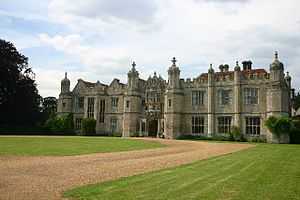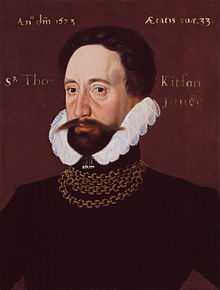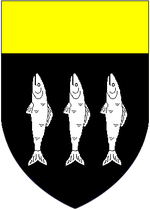Thomas Kitson
| Sir Thomas Kitson | |
|---|---|
|
Arms of Kitson: Sable, three fishes hauriant argent a chief or | |
| Born |
1485 Warton, Carnforth, Lancashire |
| Died | 11 September 1540 (aged 55) |
| Spouse(s) |
wife whose name is unknown Margaret Donnington |
| Children |
Sir Thomas Kitson Katherine Kitson Dorothy Kitson Frances Kitson Anne Kitson |
| Parent(s) | Robert Kitson, mother's name unknown |
Sir Thomas Kitson (1485 – 11 September 1540) was a wealthy English merchant, Sheriff of London, and builder of Hengrave Hall in Suffolk.
Family
Thomas Kitson was the son of Robert Kitson of Warton, Lancashire. His mother's name is unknown. His sister, Margaret Kitson, married John Washington, ancestor of George Washington.[1]
Career
Kitson came to London as a youth, and was apprenticed to the London mercer and Merchant Adventurer, Richard Glasyer. He was admitted a freeman of the Mercers' Company in 1507, and served as Warden in 1525-6 and 1533-4 and as Master in 1534-5.[2] He served as Sheriff of London in 1533-4,[2] and was knighted on 30 May of that year, an honour not conferred on his co-sheriff, William Forman. In May 1534 he was associated with Rowland Lee, Bishop of Coventry and Lichfield, in taking oaths of fealty from priests and monks.
Kitson had financial dealings with the Crown on a large scale. By 1509 his mercantile transactions were already extensive, and by 1534-5 only ten other merchants exported cloth in larger quantities.[2] He was a member of the Company of Merchant Adventurers until his death,[2] and traded at the cloth fairs or staples held by the company at Antwerp, Middelburg, and elsewhere in Flanders.

Kitson had a house in London on Milk Street with a chapel, a garden on Coleman Street, and a house and chapel in Stoke Newington. Like other wealthy London merchants he had a house in Antwerp. He also purchased properties in the counties of Devon, Dorset and Somerset, and in 1521 acquired from Edward Stafford, 3rd Duke of Buckingham, for £2340, the manors of Hengrave in Suffolk and Colston Bassett in Nottinghamshire.[2] On the Duke's attainder and execution in the following year, Kitson was for a time deprived of the estates, but they were restored to him, confirmed by an Act of Parliament of 1524. He obtained a license from Henry VIII to build an embattled manor house at Hengrave on a magnificent scale. The building was begun in 1525, and finished in 1538. A later inventory of the furniture and goods at Hengrave shows its extent and elegance. Kitson subsequently purchased several other manors in Suffolk from the crown. Besides Hengrave, he had houses at Westley and Risby in Suffolk.
Kitson died 11 September 1540, and was buried in Hengrave Church.[2] In the north-east angle of the chapel is an ornate monument to the memory of his widow, Margaret, Countess of Bath, and her three husbands.[3]
Marriages and issue
Kitson married twice:
First marriage
Firstly to a lady of unknown name. By her he had a daughter:
- Elizabeth Kitson, the first wife of Edmund Croftes (d. 14 February 1558) of Westow Hall, Little Saxham, Suffolk, son and heir of Sir John Croftes (d. 28 January 1558), who was in the service of Mary Tudor. Elizabeth Kitson bore Edmund Croftes two sons:
- Thomas Croftes
- Henry Croftes
- Elizabeth Kitson, the first wife of Edmund Croftes (d. 14 February 1558) of Westow Hall, Little Saxham, Suffolk, son and heir of Sir John Croftes (d. 28 January 1558), who was in the service of Mary Tudor. Elizabeth Kitson bore Edmund Croftes two sons:
- After Elizabeth's death Edmund Croftes remarried to Eleanor Burgh, the daughter of Thomas Burgh, 1st Baron Burgh, by whom he had a son, John Croftes, and two daughters, Margaret and Alice[4]
Second marriage
Secondly, Thomas Kitson married Margaret Donnington (d. 12 January 1561), the only child and sole heiress of John Donnington (d.1544) of Stoke Newington, a member of the Worshipful Company of Salters,[5][6] by his wife Elizabeth Pye, by whom he had a son born posthumously and four daughters:[2]


- Sir Thomas Kitson (1540–1603), who married firstly Jane Paget, the daughter of William Paget, 1st Baron Paget, by whom he had no issue, and secondly Elizabeth Cornwallis, the eldest daughter of Sir Thomas Cornwallis (d.1604), by whom he had a son who died as an infant and two daughters, Margaret, who married Sir Charles Cavendish (November 1553 – 4 April 1617) (son of Sir William Cavendish by his wife Bess of Hardwick) by whom she had no issue,[7] and Mary, who married Thomas Darcy, 3rd Baron Darcy of Chiche.[8]
- Katherine Kitson, who married Sir John Spencer (1524 – 8 November 1586) of Althorpe, Northamptonshire, and Wormleighton, Warwickshire,[9] by whom she had four sons and six daughters including:
- John Spencer, MP, ancestor of the Earls Spencer and the Dukes of Marlborough.
- Thomas Spencer
- William Spencer
- Richard Spencer, and six daughters.[10]
- Elizabeth Spencer, who in 1574 married George Carey, 2nd Baron Hunsdon, eldest son of Queen Elizabeth's cousin, Henry Carey, 1st Baron Hunsdon
- Anne Spencer, who in 1575 married William Stanley, 3rd Baron Monteagle (c.1529-1581), and in 1592 Robert Sackville, 2nd Earl of Dorset
- Alice Spencer, who in 1579 married Ferdinando Stanley, 5th Earl of Derby (c.1559-1594). The three Spencer sisters were 'Phyllis, Charillis, and sweet Amaryllis’ in the poet Edmund Spenser's Colin Clout’s Come Home Again (1595).[11]
- Katherine Kitson, who married Sir John Spencer (1524 – 8 November 1586) of Althorpe, Northamptonshire, and Wormleighton, Warwickshire,[9] by whom she had four sons and six daughters including:
- Dorothy Kitson (1531–1577), who married firstly Sir Thomas Pakington (died 2 June 1571) of Hampton Lovett, Worcestershire, by whom she had four sons, Sir John, Henry, Robert and Thomas, and three daughters, Margaret, Katherine and Mary,[10] and secondly Thomas Tasburgh (c.1554–c.1602) of Hawridge, Buckinghamshire, by whom she had no issue.[12][13]
- Frances Kitson, who married firstly on 11 December 1548[14] her step-brother John Bourchier, Lord FitzWarin (who predeceased his father), eldest son of John Bourchier, 2nd Earl of Bath, by whom she had a son, William Bourchier, 3rd Earl of Bath, and secondly she married William Barnaby of Great Saxham, Suffolk.[10] Her monument with recumbent effigy exists in the south chancel aisle built by her father-in-law and step-father[15][lower-alpha 1] in Tawstock Church, Devon, next to the Bourchier seat of Tawstock Court, and is covered by the earliest six-columned canopy in Devon.[16]
- Anne Kitson, who married, as his first wife, Sir William Spring of Pakenham, Suffolk.[17]
- Margaret Donnington married secondly, within a few months of Kitson's death, Sir Richard Long (d.1546) of Wiltshire, Great Saxham and Shingay, Cambridgeshire, Gentleman of the Privy Chamber to King Henry VIII, by whom she had a son, Henry Long, and three daughters, Jane, Katherine and Mary.[2] She married thirdly, in 1548, as his third wife, John Bourchier, 2nd Earl of Bath (d.1560), by whom she had two daughters, Susan and Bridget.[18] Margaret Donnington was a strong-minded lady who insisted that at the same time as her marriage to Bourchier, his son and heir should marry her own daughter Frances Kitson. The double marriage took place at Hengrave on 11 December 1548.[14] Thus the 2nd Earl's eldest son from his 2nd marriage to Eleanor Manners,[19] John Bourchier, Lord FitzWarin (who predeceased his father), married his own step-sister, Francesca Kitson, and was by her the father of William Bourchier, 3rd Earl of Bath. Margaret Donnington and Bourchier made Hengrave their home[20] and Bourchier was buried at Hengrave.[21] Stained glass in the cloister of Hengrave Hall survives memorialising the Bourchier residency, showing ten quarterings of Bourchier (Bourchier, Louvaine, FitzWarin, Audley, Cogan, Hankford, Brewer,[22] Martin, Dinham, Arches) impaling Donnington (Argent, three pallets azure on a chief gules three bezants)[23]
Notes
- ↑ Above the external door to the south chancel aisle are displayed the arms of the builder and his wife, 2nd Earl of Bath and Eleanor Manners.
- ↑ Washington family, Sulgrave Manor, Northamptonshire Retrieved 15 July 2013.
- ↑ 2.0 2.1 2.2 2.3 2.4 2.5 2.6 2.7 Welch & Archer 2004.
- ↑ Howard 1868, p. 89.
- ↑ Rokewode 1838, pp. 135–136.
- ↑ Rowe 2004.
- ↑ 'Stoke Newington: Other estates', A History of the County of Middlesex: Volume 8: Islington and Stoke Newington parishes (1985), pp. 178-184 Retrieved 28 April 2013.
- ↑ Cavendish, Sir Charles (1553-1617), of Welbeck Abbey, Nottinghamshire, History of Parliament Retrieved 28 April 2013.
- ↑ Corder 1981, pp. 60–1.
- ↑ Spencer, Sir John (1524-86), of Althorpe, Northamptonshire, and Wormleighton, Warwickshire, History of Parliament Retrieve 28 April 2013.
- ↑ 10.0 10.1 10.2 Corder 1981, p. 61.
- ↑ Child 1866, p. 399.
- ↑ Carter 2004.
- ↑ Tasburgh, Thomas (c.1554-1602), of Hawridge, Buckinghamshire, History of Parliament Retrieved 28 April 2013.
- ↑ 14.0 14.1 Lauder 2002, pp. 152-133.
- ↑ Lauder 2002, p. 152; Hoskins 1959, p.
- ↑ Pevsner, Nikolaus & Cherry, Bridget, The Buildings of England: Devon, London, 2004, p.790
- ↑ Corder 1981, p. 61; Burke, Burke & Burke 1838, p. 510.
- ↑ Corder 1981, pp. 61–2
- ↑ Vivian 1895, p. 107.
- ↑ Lauder 2002, p. 152.
- ↑ Lauder 2002, p. 152; thepeerage.com
- ↑ Per Rokewode 1838, p. 219: "Gules, two bendlets wavy or. In this 7th position are shown elsewhere the arms of Stapledon (of Annery, Monkleigh): Argent, two bars wavy sable, e.g. on monument of Lady Frances Bourchier (d.1612) in the Earl of Bedford's Chenies Chapel, Bucks. ("www.middlesex-heraldry.org.uk".) & sculpted on gatehouse of Tawstock Court, Devon)
- ↑ Rokewode 1838, pp. 218-219.
References
- Burke, John; Burke, John Bernard (1838). A Genealogical and Heraldic History of the Extinct and Dormant Baronetcies of England. London: Scott, Webster and Geary. p. 510. Retrieved 27 April 2013.
- Carter, P.R.N. (2004). "Tasburgh , Dorothy (other married name Dorothy Pakington, Lady Pakington) (1531–1577)". Oxford Dictionary of National Biography (online ed.). Oxford University Press. doi:10.1093/ref:odnb/68014. (Subscription or UK public library membership required.)
- Child, Francis J. (1866). The Poetical Works of Edmund Spenser IV. Boston: Little Brown and Company. p. 399. Retrieved 28 April 2013.
- Corder, Joan, ed. (1981). The Visitation of Suffolk, 1561 I. London: Whittaker and Co. pp. 58–62. Retrieved 28 April 2013.
- Hoskins, W.G. (1959) [1954]. A New Survey of England: Devon. London.
- Howard, Joseph Jackson, ed. (1868). The Visitation of Suffolk II. London: Whittaker and Co. pp. 83–108. Retrieved 28 April 2013.
- Lauder, Rosemary (2002). Devon Families, Tiverton. p. 152.
- Rokewode, Joseph Gage (1838). The History and Antiquities of Suffolk; Thingoe Hundred. London: Samuel Bentley. pp. 134–6. Retrieved 28 April 2013.
- Rowe, Joy (2004). "Kitson family (per. c.1520–c.1660)". Oxford Dictionary of National Biography (online ed.). Oxford University Press. doi:10.1093/ref:odnb/73910. (Subscription or UK public library membership required.)
- Vivian, Lt.Col. J.L., ed. (1895). The Visitation of the County of Devon: Comprising the Heralds' Visitations of 1531, 1564 & 1620. Exeter. p. 107.
- Welch, Charles; Archer, Ian W. (reviewer) (2004). "Kitson, Sir Thomas (1485–1540)". Oxford Dictionary of National Biography (online ed.). Oxford University Press. doi:10.1093/ref:odnb/15833. (Subscription or UK public library membership required.) The first edition of this text is available as an article on Wikisource:
 Lee, Sidney, ed. (1892). "Kytson, Thomas". Dictionary of National Biography 31. London: Smith, Elder & Co. p. 364.
Lee, Sidney, ed. (1892). "Kytson, Thomas". Dictionary of National Biography 31. London: Smith, Elder & Co. p. 364.
Further reading
- Howard, Joseph Jackson, ed. (1866). The Visitation of Suffolk I. London: Whittaker and Co. p. 191. Retrieved 27 April 2013.
External links
- Will of Sir Thomas Kitson of Hengrave, Suffolk, proved 22 September 1540, PROB 11/29/2, National Archives Retrieved 15 July 2013
- Will of Edmund Croft of West Stow, Suffolk, proved 13 November 1558, National Archives Retrieved 28 April 2013
- 'Parishes: Shingay', A History of the County of Cambridge and the Isle of Ely: Volume 8 (1982), pp. 124-127 Retrieved 28 April 2013
